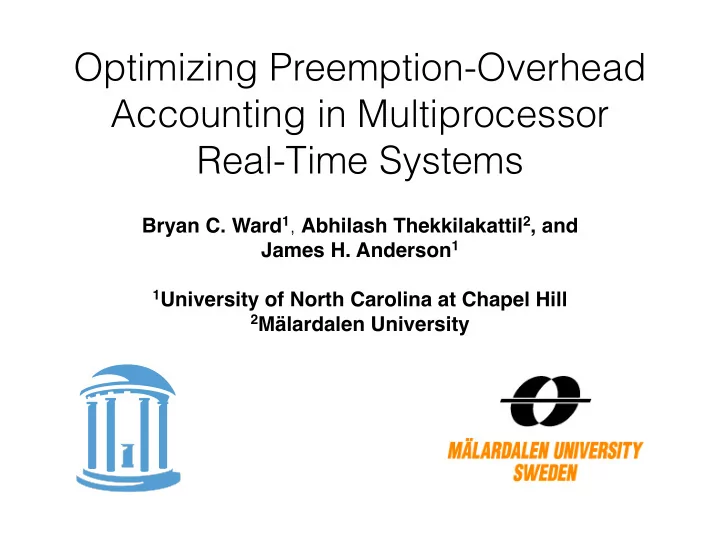

Optimizing Preemption-Overhead Accounting in Multiprocessor Real-Time Systems Bryan C. Ward 1 , Abhilash Thekkilakattil 2 , and � James H. Anderson 1 � � 1 University of North Carolina at Chapel Hill � 2 Mälardalen University � �
Motivation Real systems experience runtime overheads, which must be accounted for in schedulability analysis. Practice Theory
Preemption Overheads • Loss of cache affinity • Scheduling T 1 • Context switching T 2 • Pipeline delays • …
Preemption-Overhead Accounting • Inflate execution costs to account for overheads. • Two main approaches: • Task centric, • Preemption centric. • Our contribution: a hybrid of these two.
Task Centric • Each task’s execution time is inflated to account for every possible preemption. • Requires preemption-count bounds. More tasks make matters worse! T 1 T 2
Preemption Centric • The relinquishing task is charged the overhead. The relinquishing task must pay for the largest overhead of any resuming task. But each task must only pay for one preemption. T 1 T 2
Tradeoff Task Centric Preemption Centric Pessimism source: Pessimism source: preemption count. preemption cost. Our Contribution: formalized and explored the space between the two extremes.
ARPO • Analytical Redistribution of Preemption Overheads • Hybrid approach: relinquishing task “pays” some, resuming task “pays” the rest. T 1 T 2
Details • Every task pays a global charge, G. • Each task pays the difference between the actual overhead and the global charge. • Large G: preemption centric. • G = 0: task centric. • Applicable to any job-level fixed-priority scheduler, i.e. , G-EDF, G-FP.
Linear Program • Optimization objective: minimize utilization • Subject to: • Inflated cost >= Original + Local Charge + G. • G >= 0. • Inflated per-task utilization <= 1.
Limited Preemptions • To avoid preemption overheads, preemptions can be limited to specific preemption points. • ARPO can also be applied to these schedulers. • Number of preemption points is the preemption- count bound.
Schedulability Framework • Periods & utilizations chosen similarly to prior work. • WSS chosen corresponding to execution cost. • 9 different distributions (uniform, constant, bimo). • Previous studies considered a single WSS for all tasks. • Produced over 200 schedulability graphs.
G-EDF Schedulability ������������������ � ����������� ���� ��� ��� Schedulability ��� ��� ��� ��� � � � � � � � Utilization
Extensions • SRT - Optimizing for utilization is optimal. • HRT: • Integrate with ILP-based RTA. • Added utilization-based schedulability test* as a constraint. (didn’t work well). *J. Goossens, S. Funk, and S. Baruah. Priority-driven scheduling of periodic task systems on multiprocessors. Real-Time Systems, 2003.
Conclusions • ARPO is a hybrid of task- and preemption-centric overhead accounting. • Based on linear programming. • Developed a new schedulability framework with non-constant WSSs. • Improved schedulability.
Questions?
Recommend
More recommend